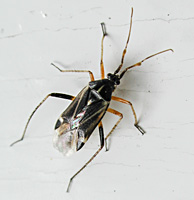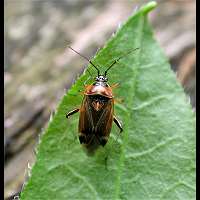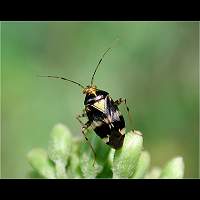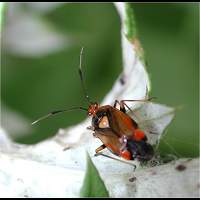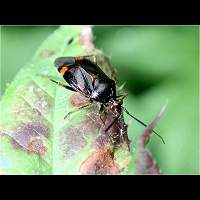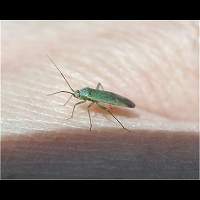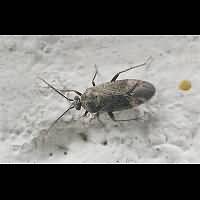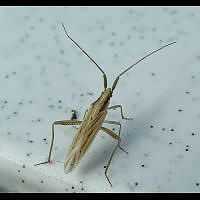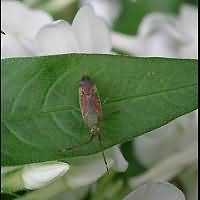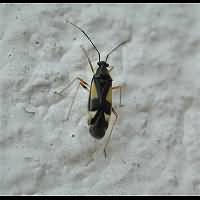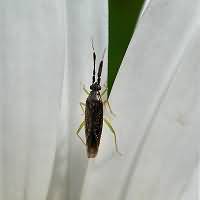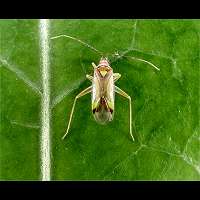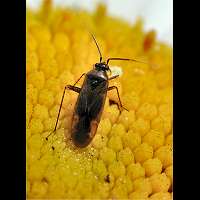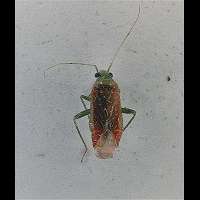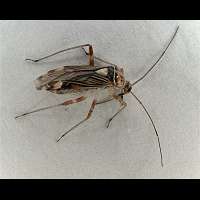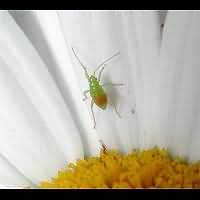[All pictures of garden wildlife on this page are thumbnails. Click on any thumbnail for a large format to be displayed.]
This a big family of small bugs, varying in length from 3 to 8 mm. They do look a lot like the Seed Bugs, but a lot of species are more colourful. Plant Bugs usually have quite long antennae and they lack the ocelli found in Seed Bugs. That is why they are called Blind Bugs in many languages. In Central Europe we find some 300 species, some of which are very hard to identify. It may help if you know the plant species being sucked by the bug, for many similar bugs specialize on one kind of host plant only, allowing you to name the species in spite of the similarity with other species. Almost all Plant Bugs are adult in summer and autumn and the eggs overwinter. Even though a few species do hunt for other small insects, most feed on plants all their life. The adults are found in flowers regularly. A few Plant Bugs are harmful in agriculture, such as the Potato Bug and the Common Green Capsid.
Red Bug Deraeocoris ruber
This is the less colourful variety of the Red Bug in which the animals are blackish mainly. More...
This is the less colourful variety of the Red Bug in which the animals are blackish mainly. More...
Lucerne Bug (Adelphocoris lineolatus)
Reaching 8 to 10 mm in length this plant bug is relatively large. There are other similar pale greenish bugs but most of them are smaller. More...
Reaching 8 to 10 mm in length this plant bug is relatively large. There are other similar pale greenish bugs but most of them are smaller. More...
Common Green Capsid Lygocoris pabulinus
The Common Green Capsid is much feared in the cultivation of apples and pears. more...
The Common Green Capsid is much feared in the cultivation of apples and pears. more...
Orthotylus virescens
Orthotylus virescens can by identified by its short nose and its foodplant: Broom. More about this species soon.
Orthotylus virescens can by identified by its short nose and its foodplant: Broom. More about this species soon.
Grass Bug Stenodema laevigatum
The peculiar shape of the Grass Bug makes it stand out among the Plant Bugs. More....
The peculiar shape of the Grass Bug makes it stand out among the Plant Bugs. More....
Pantilius tunicatus
During its life span Pantilius tunicatus changes its colour from green to almost entirely red. More....
During its life span Pantilius tunicatus changes its colour from green to almost entirely red. More....
Dryophilocoris flavoquadrimaculatus
Dryophilocoris flavoquadrimaculatus belongs to a large group of similar yellow and black Plant Bugs. more...
Dryophilocoris flavoquadrimaculatus belongs to a large group of similar yellow and black Plant Bugs. more...
Heterotoma planicornis
Quite common in gardens in Western and Central Europe: Heterotoma planicornis. The antennae are quite weird. more...
Quite common in gardens in Western and Central Europe: Heterotoma planicornis. The antennae are quite weird. more...
Campyloneura virgula
Photographing Campyloneura virgula is very difficult, for it tends to run a lot and extremely fast. more...
Photographing Campyloneura virgula is very difficult, for it tends to run a lot and extremely fast. more...
Plagiognathus arbustorum
Plagiognathus arbustorum is very variable. Some animals are almost white. more...
Plagiognathus arbustorum is very variable. Some animals are almost white. more...
Dichrooscytus rufipennis
Some bugs are best identified by looking at their host plant. Dichrooscytus rufipennis for instance lives on Scots Pine only. more...
Some bugs are best identified by looking at their host plant. Dichrooscytus rufipennis for instance lives on Scots Pine only. more...
Rhabdomiris striatellus
Rhabdomiris striatellus is common all over Britain, used to be called Calocoris striatellus scientifically, but has no common English name. more...
Rhabdomiris striatellus is common all over Britain, used to be called Calocoris striatellus scientifically, but has no common English name. more...
Macrolophus pygmaeus
Very similar to Macrolophus rubi but differs in that the 3rd antennal segment is only around 1.75 times as long as the 4th, rather than twice as long. Adults reach 3-4mm and can be found from May to July. Since a few years tomato and eggplant growers get support from this predatory bug to control whiteflies. It is also known to eat spider mite, moth eggs and aphids.
Very similar to Macrolophus rubi but differs in that the 3rd antennal segment is only around 1.75 times as long as the 4th, rather than twice as long. Adults reach 3-4mm and can be found from May to July. Since a few years tomato and eggplant growers get support from this predatory bug to control whiteflies. It is also known to eat spider mite, moth eggs and aphids.

© Copyright 1998-2024 gardensafari.net (Hania Berdys)

 English / engels
English / engels  Dutch / nederlands
Dutch / nederlands